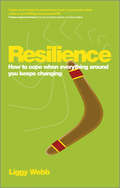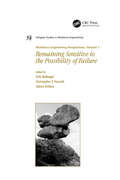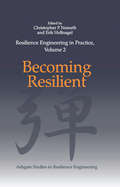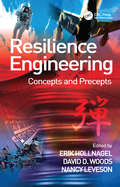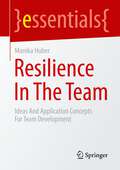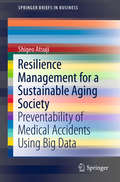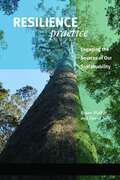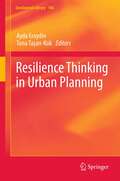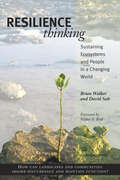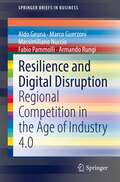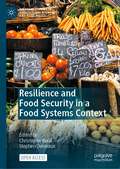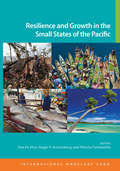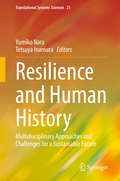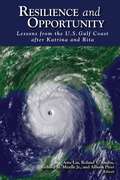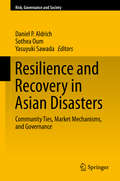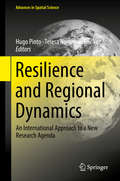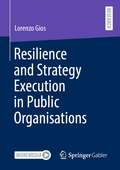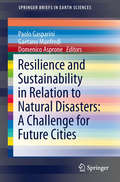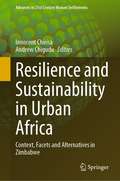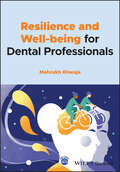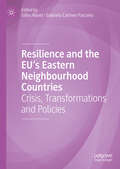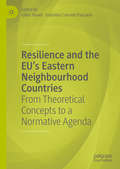- Table View
- List View
Resilience
by Liggy WebbBOUNCE BACK FROM WHATEVER LIFE THROWS AT YOUStressful situations are a fact of life. Job insecurity, financial burden, relationship doubt are all too familiar. Some people approach them with confidence and poise, facing change and challenges head on. Others back away slowly into a corner and become quivering wrecks at the mere thought of them. So what is it that makes some people cope with these adverse situations so well? It's not about what is happening to you, but how you react to it. It's about your resilience.Happiness guru Liggy Webb is here to help us all find positivity and inner strength to cope with stressful situations. Arming you with a personal toolkit to handle day to day challenges, and providing strategies for thriving in uncertain times Liggy shows you how to increase your 'bouncibility' and bounce back from whatever negative things life throws at you.* Timely topic with governments across the world promoting happiness on the one hand and dealing with vast economic uncertainty and austerity on the other * Easy to digest, anecdotal and practical guide with lots of common sense advice* Contains timely examples and tips tailored for coping with difficult times
Resilience Engineering Perspectives, Volume 1: Remaining Sensitive to the Possibility of Failure (Ashgate Studies in Resilience Engineering)
by Christopher P. NemethIn the resilience engineering approach to safety, failures and successes are seen as two different outcomes of the same underlying process, namely how people and organizations cope with complex, underspecified and therefore partly unpredictable work environments. Therefore safety can no longer be ensured by constraining performance and eliminating risks. Instead, it is necessary to actively manage how people and organizations adjust what they do to meet the current conditions of the workplace, by trading off efficiency and thoroughness and by making sacrificing decisions. The Ashgate Studies in Resilience Engineering series promulgates new methods, principles and experiences that can complement established safety management approaches, providing invaluable insights and guidance for practitioners and researchers alike in all safety-critical domains. While the Studies pertain to all complex systems they are of particular interest to high hazard sectors such as aviation, ground transportation, the military, energy production and distribution, and healthcare. Published periodically within this series will be edited volumes titled Resilience Engineering Perspectives. The first volume, Remaining Sensitive to the Possibility of Failure, presents a collection of 20 chapters from international experts. This collection deals with important issues such as measurements and models, the use of procedures to ensure safety, the relation between resilience and robustness, safety management, and the use of risk analysis. The final six chapters utilise the report from a serious medical accident to illustrate more concretely how resilience engineering can make a difference, both to the understanding of how accidents happen and to what an organisation can do to become more resilient.
Resilience Engineering in Practice, Volume 2: Becoming Resilient (Ashgate Studies in Resilience Engineering)
by Erik Hollnagel Christopher P. NemethThis is the fifth book published within the Ashgate Studies in Resilience Engineering series. The first volume introduced resilience engineering broadly. The second and third volumes established the research foundation for the real-world applications that then were described in the fourth volume: Resilience Engineering in Practice. The current volume continues this development by focusing on the role of resilience in the development of solutions. Since its inception, the development of resilience engineering as a concept and a field of practice has insisted on expanding the scope from a preoccupation with failure to include also the acceptable everyday functioning of a system or an organisation. The preoccupation with failures and adverse outcomes focuses on situations where something goes wrong and the tries to keep the number of such events and their (adverse) outcomes as low as possible. The aim of resilience engineering and of this volume is to describe how safety can change from being protective to become productive and increase the number of things that go right by improving the resilience of the system.
Resilience Engineering: Concepts and Precepts (Ashgate Studies In Resilience Engineering Ser.)
by David D. WoodsFor Resilience Engineering, 'failure' is the result of the adaptations necessary to cope with the complexity of the real world, rather than a breakdown or malfunction. The performance of individuals and organizations must continually adjust to current conditions and, because resources and time are finite, such adjustments are always approximate. This definitive new book explores this groundbreaking new development in safety and risk management, where 'success' is based on the ability of organizations, groups and individuals to anticipate the changing shape of risk before failures and harm occur. Featuring contributions from many of the worlds leading figures in the fields of human factors and safety, Resilience Engineering provides thought-provoking insights into system safety as an aggregate of its various components, subsystems, software, organizations, human behaviours, and the way in which they interact. The book provides an introduction to Resilience Engineering of systems, covering both the theoretical and practical aspects. It is written for those responsible for system safety on managerial or operational levels alike, including safety managers and engineers (line and maintenance), security experts, risk and safety consultants, human factors professionals and accident investigators.
Resilience In The Team: Ideas And Application Concepts For Team Development (essentials)
by Monika HuberThis essential provides insights into approaches, procedures and ideas on how resilience, understood as resistance, can be promoted and implemented in a team. Most of the time, these concepts are only applied to individuals. But many of the findings from resilience research can be transferred to teams and even extended. Today, resilience is also playing an increasingly important role in teams: whether it is to strengthen the sense of coherence according to Antonovsky's principle of salutogenesis, or to consider other resilience factors that support team capability
Resilience Management for a Sustainable Aging Society: Preventability of Medical Accidents Using Big Data (SpringerBriefs in Business)
by Shigeo AtsujiThis book utilizes big data to undertake a cluster analysis of medical accidents. Highlighting shared worldwide accident patterns, it represents a first step toward reducing the incidence of accidents through kaizen innovation driven by information and communications technology. This initiative comes against a background where medical accidents are currently the third largest cause of death after heart attack and cancer, making accident prevention an urgent concern. With the objective of preventing these accidents, which negatively impact numerous different stakeholders, and based on interdisciplinary research, the book examines (1) the application of data mining to identify shared accident patterns; (2) proposals for system improvement and organizational innovation aimed at risk and resilience in crisis management; and (3) the use of a global platform to achieve sustainability in the Internet of Medicine (IoM).
Resilience Practice: Building Capacity To Absorb Disturbance And Maintain Function
by Brian Walker & David SaltIn 2006, Resilience Thinking addressed an essential question: As the natural systems that sustain us are subjected to shock after shock, how much can they take and still deliver the services we need from them? This idea caught the attention of both the scientific community and the general public. In Resilience Practice, authors Brian Walker and David Salt take the notion of resilience one step further, applying resilience thinking to real-world situations and exploring how systems can be managed to promote and sustain resilience. The book begins with an overview and introduction to resilience thinking and then takes the reader through the process of describing systems, assessing their resilience, and intervening as appropriate. Following each chapter is a case study of a different type of social-ecological system and how resilience makes a difference to that system in practice. The final chapters explore resilience in other arenas, including on a global scale. Resilience Practice will help people with an interest in the “coping capacity” of systems—from farms and catchments to regions and nations—to better understand how resilience thinking can be put into practice. It offers an easy-to-read but scientifically robust guide through the real-world application of the concept of resilience and is a must read for anyone concerned with the management of systems at any scale.
Resilience Recipes: Making Space for Wellbeing That Works
by Fleur HeazlewoodA quick-start, evidence-based guide for finding wellbeing at home and at work. Resilience Recipes is for real people facing real-time challenges every day. Whether they are feeling overworked or overwhelmed, this book will teach them strategies to manage stress, find more balance in their life and bounce back. They need to make space for their own wellbeing to function as their best self. Starting with a wellbeing self-assessment test, readers remind themselves about what is important to them, before they are encouraged to dive into the resilience recipes that will improve their wellbeing. The chapters that follow focus on rebuilding emotional resilience, practicing mindfulness to increase mental adaptability and finish with strategies to re-energize and remain stronger going forward. The reality is that wellbeing isn't a nice-to-have – it is a must-have. It is necessary for health, energy, connection, creativity, relationships, performance... the list goes on. Fleur Heazlewood is a leadership expert who has trained and mentored over 1000 people in positive leadership, mental health mastery and resilience.
Resilience Thinking in Urban Planning
by Tuna Taşan-Kok Ayda EraydinThere is consensus in literature that urban areas have become increasingly vulnerable to the outcomes of economic restructuring under the neoliberal political economic ideology. The increased frequency and widening diversity of problems offer evidence that the socio-economic and spatial policies, planning and practices introduced under the neoliberal agenda can no longer be sustained. As this shortfall was becoming more evident among urban policymakers, planners, and researchers in different parts of the world, a group of discontent researchers began searching for new approaches to addressing the increasing vulnerabilities of urban systems in the wake of growing socio-economic and ecological problems. This book is the joint effort of those who have long felt that contemporary planning systems and policies are inadequate in preparing cities for the future in an increasingly neoliberalising world. It argues that "resilience thinking" can form the basis of an alternative approach to planning. Drawing upon case studies from five cities in Europe, namely Lisbon, Porto, Istanbul, Stockholm, and Rotterdam, the book makes an exploration of the resilience perspective, raising a number of theoretical debates, and suggesting a new methodological approach based on empirical evidence. This book provides insights for intellectuals exploring alternative perspectives and principles of a new planning approach.
Resilience Thinking: Sustaining Ecosystems and People in a Changing World
by Brian Walker David Salt Walter ReidIncreasingly, cracks are appearing in the capacity of communities, ecosystems, and landscapes to provide the goods and services that sustain our planet's well-being. The response from most quarters has been for "more of the same" that created the situation in the first place: more control, more intensification, and greater efficiency. "Resilience thinking" offers a different way of understanding the world and a new approach to managing resources. It embraces human and natural systems as complex entities continually adapting through cycles of change, and seeks to understand the qualities of a system that must be maintained or enhanced in order to achieve sustainability. It explains why greater efficiency by itself cannot solve resource problems and offers a constructive alternative that opens up options rather than closing them down. In Resilience Thinking, scientist Brian Walker and science writer David Salt present an accessible introduction to the emerging paradigm of resilience. The book arose out of appeals from colleagues in science and industry for a plainly written account of what resilience is all about and how a resilience approach differs from current practices. Rather than complicated theory, the book offers a conceptual overview along with five case studies of resilience thinking in the real world. It is an engaging and important work for anyone interested in managing risk in a complex world.
Resilience and Digital Disruption: Regional Competition in the Age of Industry 4.0 (SpringerBriefs in Business)
by Marco Guerzoni Aldo Geuna Massimiliano Nuccio Fabio Pammolli Armando RungiThis book focuses on how digital technologies and rapid developments in artificial intelligence are shaping a new generation of cyber-physical systems based on the convergence among robots, sensors, and 3D printing. The book tells a story based on data and indicators to compare the resilience to this transformation in some key manufacturing regions. As a specific case study, the book discusses in length the transformation of the manufacturing processes in the Italian automotive industry. The authors conclude the book by providing policy implications for regions and cities.
Resilience and Food Security in a Food Systems Context (Palgrave Studies in Agricultural Economics and Food Policy)
by Stephen Devereux Christophe BénéThis open access book compiles a series of chapters written by internationally recognized experts known for their in-depth but critical views on questions of resilience and food security. The book assesses rigorously and critically the contribution of the concept of resilience in advancing our understanding and ability to design and implement development interventions in relation to food security and humanitarian crises. For this, the book departs from the narrow beaten tracks of agriculture and trade, which have influenced the mainstream debate on food security for nearly 60 years, and adopts instead a wider, more holistic perspective, framed around food systems. The foundation for this new approach is the recognition that in the current post-globalization era, the food and nutritional security of the world’s population no longer depends just on the performance of agriculture and policies on trade, but rather on the capacity of the entire (food) system to produce, process, transport and distribute safe, affordable and nutritious food for all, in ways that remain environmentally sustainable. In that context, adopting a food system perspective provides a more appropriate frame as it incites to broaden the conventional thinking and to acknowledge the systemic nature of the different processes and actors involved. This book is written for a large audience, from academics to policymakers, students to practitioners.This is an open access book.
Resilience and Growth Through Sustained Adjustment
by Saleh M. NsouliA report from the International Monetary Fund.
Resilience and Growth in the Small States of the Pacific
by Patrizia Tumbarello Hoe Ee Khor Roger P. KronenbergDiscusses ongoing challenges facing Pacific island countries and policy options to address them. Regional cooperation and solutions and further integration with the Asia and Pacific region will also play a role. In short, unique challenges call for tailored solutions, and with concerted efforts, Pacific island countries can boost potential growth, increase resilience, and improve the welfare of their citizens.
Resilience and Human History: Multidisciplinary Approaches and Challenges for a Sustainable Future (Translational Systems Sciences #23)
by Yumiko Nara Tetsuya InamuraThis unique book provides a platform for resilience research, combining knowledge from various domains, such as genetics, primatology, archeology, geography, physical anthropology, cultural anthropology, medicine, ecology, psychology, risk management and systems science, in order to examine specific concepts. The term "resilience" was originally used in psychology, but in current-day usage, it mainly refers to the "ability to recover from disaster"; however, the concept of resilience is still ambiguous. This book challenges readers to reconsider the concept of resilience comprehensively from diverse perspectives and to re-conceptualize it as an important framework applicable in various research fields. The book explores resilience by expanding the time and space scales to the maximum. On the time axis, it traces back to our human ancestors (and even to anthropoid apes) and follows the evolution of humans, the origin of agriculture, the rise and fall of ancient civilizations, and the present day. On the space axis, it discusses levels ranging from genetic; bacterial flora; individual, indigenous communities; and modern societies; to the global level. As such it expands the base for considering the problems facing modern society and selecting a future direction. In the long history of evolution, we Homo sapiens have faced, and overcome, various kinds of risks. By acquiring resilience, we have surpassed other animals and become apparent rulers of the earth; but, at the same time, we are also facing more serious risks than ever before. This book provides insights into addressing the challenges of a sustainable future.
Resilience and Opportunity
by Roland V. Anglin Allison Plyer Amy Liu Richard M. MizelleHurricanes Katrina and Rita devastated the Gulf Coast in 2005. Commentary and analysis typically focused on what went wrong in the post-disaster emergency response. This forward-looking book, however, presents a more cautiously optimistic view about the region's ability to bounce back after multiple disasters.Catastrophes come in different forms-hurricanes, recessions, and oil spills, to name a few. It is imperative that we learn how best to rebuild in the wake of disasters and what capacities and conditions are needed to improve future resilience. Since the devastating summer of 2005, leaders have made important inroads to restoring communities in more prosperous ways. Resilience and Opportunity is an important contribution to our collective learning from a teachable moment.Contributors: Ivye Allen, Foundation for the Mid South; Lance Buhl, Duke University; Ann Carpenter, Federal Reserve Bank of Atlanta; Robert A. Collins, Dillard University; Mark S. Davis, Tulane University Law School; Breonne DeDecker, Brandeis University; Karen B. DeSalvo, Tulane University School of Medicine; Kathryn A. Foster, University at Buffalo Regional Institute, SUNY; Linetta Gilbert, The Declaration Initiative; Ambassador James Joseph, Duke University; Mukesh Kumar, Jackson State University; Luceia LeDoux, Baptist Communities Ministries; Silas Lee III, Xavier University of Louisiana; David A. Marcello, Tulane University; Richard McCline, Southern University; Nancy T. Montoya, Federal Reserve Bank of Atlanta; Reilly Morse, Mississippi Center for Justice; Elaine Ortiz, Greater New Orleans Community Data Center; Andre Perry, Loyola University, New Orleans; John L. Renne, University of New Orleans; Kalima Rose, PolicyLink; Michael Schwam-Baird, Tulane University; Jasmine M. Waddell, Brandeis University; Nadiene Van Dyke, New Orleans Police and Justice Foundation; Alandra Washington, W. K. Kellogg Foundation; Frederick Weil, Louisiana State University; Leslie Willams, LeaderShift Consulting; Jon Wool, Vera Institute of Justice.
Resilience and Opportunity: Lessons from the U. S. Gulf Coast after Katrina and Rita
by Roland V. Anglin Richard M. Mizelle Jr. Allison Plyer Amy LiuHurricanes Katrina and Rita devastated the Gulf Coast in 2005. Commentary and analysis typically focused on what went wrong in the post-disaster emergency response. This forward-looking book, however, presents a more cautiously optimistic view about the region's ability to bounce back after multiple disasters.Catastrophes come in different forms--hurricanes, recessions, and oil spills, to name a few. It is imperative that we learn how best to rebuild in the wake of disasters and what capacities and conditions are needed to improve future resilience. Since the devastating summer of 2005, leaders have made important inroads to restoring communities in more prosperous ways. Resilience and Opportunity is an important contribution to our collective learning from a teachable moment.Contributors: Ivye Allen, Foundation for the Mid South; Lance Buhl, Duke University; Ann Carpenter, Federal Reserve Bank of Atlanta; Robert A. Collins, Dillard University; Mark S. Davis, Tulane University Law School; Breonne DeDecker, Brandeis University; Karen B. DeSalvo, Tulane University School of Medicine; Kathryn A. Foster, University at Buffalo Regional Institute, SUNY; Linetta Gilbert, The Declaration Initiative; Ambassador James Joseph, Duke University; Mukesh Kumar, Jackson State University; Luceia LeDoux, Baptist Communities Ministries; Silas Lee III, Xavier University of Louisiana; David A. Marcello, Tulane University; Richard McCline, Southern University; Nancy T. Montoya, Federal Reserve Bank of Atlanta; Reilly Morse, Mississippi Center for Justice; Elaine Ortiz, Greater New Orleans Community Data Center; Andre Perry, Loyola University, New Orleans; John L. Renne, University of New Orleans; Kalima Rose, PolicyLink; Michael Schwam-Baird, Tulane University; Jasmine M. Waddell, Brandeis University; Nadiene Van Dyke, New Orleans Police and Justice Foundation; Alandra Washington, W. K. Kellogg Foundation; Frederick Weil, Louisiana State University; Leslie Willams, LeaderShift Consulting; Jon Wool, Vera Institute of Justice.
Resilience and Recovery in Asian Disasters
by Daniel P. Aldrich Sothea Oum Yasuyuki SawadaThis book establishes a new, holistic framework for disaster recovery and mitigation, providing a multidisciplinary perspective on the field of risk management strategies and societal and communal resilience. Going beyond narrow approaches that are all too prevalent in the field, this work builds on an optimum combination of community-level networks, private market mechanisms and state-based assistance strategies. Its chapters describe best practices in the field and elucidate cutting-edge research on recovery, highlighting the interaction between government, industry and civil society. The book uses new data from a number of recent disasters across southeast and east Asia to understand the interactions among residents, the state, and catastrophe, drawing on events in Malaysia, Vietnam, Cambodia, Japan, China and Thailand. Grounded in theories of risk mitigation and empirical research, the book provides practical guidance for decision makers along with future research directions for scholars. The Asian region is highly prone to natural disasters which devastate large and mostly poor populations. This book deals with some of the root issues underlying the continued vulnerability of these societies to catastrophic shocks. The book is unusual in that it comprehensively covers resilience and fragilities from community levels to market mechanisms and governance and it analyses these issues in very different economic and structural settings. Recommended for development and disaster risk managers--without question. Professor Debarati Guha-Sapir Director, Centre for Research on the Epidemiology of Disasters (CRED); Professor, University of Louvain, Research Institute Health and Society.
Resilience and Regional Dynamics: An International Approach to a New Research Agenda (Advances in Spatial Science)
by Hugo Pinto Teresa Noronha Eric VazEconomic and financial crises have brought the rise of unemployment, reduction of economic growth and emergence of global imbalances and tensions as countries and regions have suffered the effects of a variety of internal and external shocks. In this context of constant disruption, the scientific community has struggled to provide satisfactory answers to current economic challenges within standard frameworks. Focusing on the interconnections between innovation and resilience, this edited book contributes to a better understanding of how the crisis affects innovation and the capacity of territories to adapt and evolve. It offers both theoretical and empirical contributions that debate the notions of resilience in regional and urban contexts and serve as case studies related to innovation strategies and territorial clusters.
Resilience and Strategy Execution in Public Organisations
by Lorenzo GiosPublic organizations are often not at the centre of management studies, at the same time they are the engines of a good functioning society. In this research, organisational resilience and strategy execution are studied in the context of Italian municipalities. The thesis explores traits and characteristics allowing municipalities to successfully adapt to changes. Important results are the practical recommendations that will enable the strengthening of organisational resilience and execution characteristics. In a world where the only constant is change and a pandemic is shuffling the world paradigms, this book might represent an enlightening reading for public managers who want to fulfil the mission of their organisations.
Resilience and Sustainability in Relation to Natural Disasters: A Challenge for Future Cities
by Paolo Gasparini Gaetano Manfredi Domenico AsproneThe number of megacities worldwide is rapidly increasing and contemporary cities are also expanding fast. As a result, cities and their inhabitants are becoming increasingly vulnerable to the effects of catastrophic natural events such as extreme weather events (recently more frequent and intense as a result of the ongoing climate changes), earthquakes, tsunamis or man-induced events such as terrorist attacks or accidents. Furthermore, due to increasing technological complexity of urban areas, along with increasing population density, cities are becoming more and more risk attractors. The resilience of cities against catastrophic events is a major challenge of today. It requires city transformation processes to be rethought, to mitigate the effects of extreme events on the vital functions of cities and communities. Redundancy and robustness of the components of the urban fabric are essential to restore the full efficiency of the city's vital functions after an extreme event has taken place. These items were addressed by an interdisciplinary and international selection of scientists during the 6th UN-World Urban Forum that was held in Naples, Italy in September 2012. This volume represents in six chapters the views from sociologists, economists and scientists working on natural risk and physical vulnerability on resilience and sustainability for future cities in relation to natural disasters.
Resilience and Sustainability in Urban Africa: Context, Facets and Alternatives in Zimbabwe (Advances in 21st Century Human Settlements)
by Innocent Chirisa Andrew ChiguduResilience has become a very topical issue transcending many spheres and sectors of sustainable urban development. This book presents a resilience framework for sustainable cities and towns in Africa. The rise in informal settlements is due to the urban planning practices in most African cities that rarely reflect the realities of urban life and environment for urban development. Aspects of places, people and process are central to the concept of urban resilience and sustainable urban growth. It stems from the observation that urban vulnerability is on the increase in Zimbabwe and beyond. In history, disasters have adversely affected nations across the world, inflicting wide ranging losses on one hand while on the other hand creating development opportunities for urban communities. Cooperation in disaster management is a strategy for minimising losses and uplifting the affected urban settlements. The significance of urban planning and design in the growth and development of sustainable urban centres is well documented. Urbanisation has brought with it challenges that most developing countries such as Zimbabwe are not equipped to handle. This has been accompanied by problems such as overpopulation, overcrowding, shortages of resources and the growth of slum settlements. There need is to seriously consider urban planning and design in order to come up with contemporary designs that are resilient to current urban challenges. There are major gaps in urban resilience building for instance in Harare and the local authority needs to prioritise investment in resilient urban infrastructure.
Resilience and Well-being for Dental Professionals
by Mahrukh KhwajaResilience and Well-being for Dental Professionals Essential reading for dental professionals and other healthcare workers wanting to build emotional resilience and positive mental health Dentistry is a high-stress profession with elevated rates of anxiety, depression, burnout, suicidal thoughts and self-harm. Chronic workplace stress is a growing concern as it can severely damage the mental health of dental professionals and negatively impact their ability to provide appropriate care. Psychological interventions have been shown to greatly benefit the well-being and emotional resilience of the medical and healthcare community, yet resources that provide preventative tools are limited. Resilience and Well-being for Dental Professionals, is designed not only to combat occupational hazards in Dentistry, such as burnout and compassion fatigue, but also to build resilience, engagement at work and nurture positive mental health through a variety of evidence-based tools. This invaluable guide helps readers utilise tools from the science of well-being (Positive Psychology, Mindfulness, Cognitive Behavioural Therapy and Acceptance and Commitment Therapy), to create happier, thriving careers. It includes: Tools from resilience interventions to help dental professionals implement preventative habits and take steps towards positive mental health Focus on self awareness in recognizing burnout early Positive psychology and well-being exercises, customised for dental professionals, to help you meld together research and application: from journaling and creative exercises to nature-based and activities at work Measure and track well-being using psychological scales Manage difficult emotions, practice mindfulness and self-compassion, develop a culture of kindness and gratitude at work, utilise a growth mindset when upskilling, harness positive leadership and use strengths, with patients and at home Create habits that stick through applying the psychology of goal setting, behaviour change, motivation psychology, work-life harmony and happiness Written by a Positive Psychologist, and Dentist, with more than 12 years’ clinical dentistry experience within a stressful NHS environment, Resilience and Well-being for Dental Professionals is a must-have resource for all dental students, hygienists, therapists, dentists, dental nurses, dental technicians, specialists and allied healthcare workers.
Resilience and the EU's Eastern Neighbourhood Countries: Crisis, Transformations and Policies
by Gilles Rouet Gabriela Carmen PascariuThis new edition provides a detailed and systemic analysis of the shocks and vulnerabilities seen within Eastern Europe and their impact on medium and long-term economic stability and the sustainable development of the region. Fully revised to account for the dramatic changes within Eastern Europe since the COVID-19 pandemic and the war in Ukraine, it examines economic, social, institutional, and political fragility within countries within the Eastern part of the EU and presents an economic framework and policies form overcoming these challenges and creating greater economic resilience. A particular focus is given to issues of economic governance, long-term economic growth, energy security, job creation, and climate action. This book highlights the need of economic resilience and looks at ways EU policies can create this within Eastern Europe. It will be relevant to students, researchers, and policymakers interested in the political economy and economic policy.
Resilience and the EU's Eastern Neighbourhood Countries: From Theoretical Concepts to a Normative Agenda
by Gilles Rouet Gabriela Carmen PascariuResilience has emerged as a key concept in EU foreign policy. The policy debate around this concept has been vigorous, but theoretical attempts to develop the concept are few. Covering fields of strategical importance, such as economic governance; growth and sustainable development; energy, environment and climate action; education, the labour market, and foreign affairs, this book is one of the first attempts to profoundly theorise the concept of ‘resilience’ in international relations by looking at several policy areas and countries. Faced with multiple crises (the economic crisis, the Brexit referendum, the refugee crisis, terrorist attacks, geopolitics such as events in the Ukraine), and challenges with its integration process, the European Union needs to become not only more intelligent, more inclusive and more sustainable, but also more resilient and more capable of reacting to different internal and external shocks. This book integrates a systemic assessment of the regions’ specific shocks and risks in relation to internal vulnerabilities (i.e. structural economic, social, institutional and political fragility) and to their long and medium-term impact on the stability, security and sustainable development in the region.
